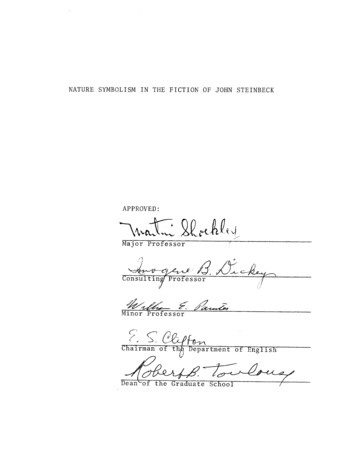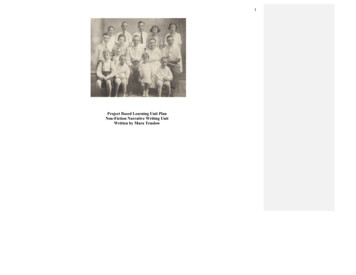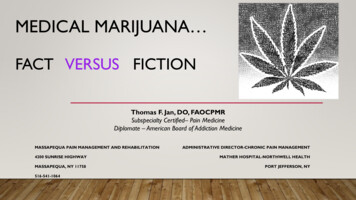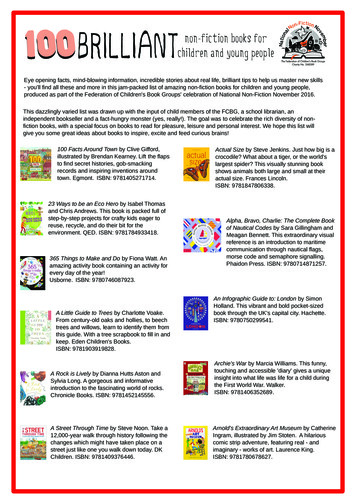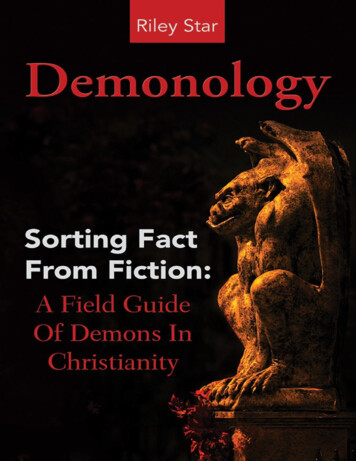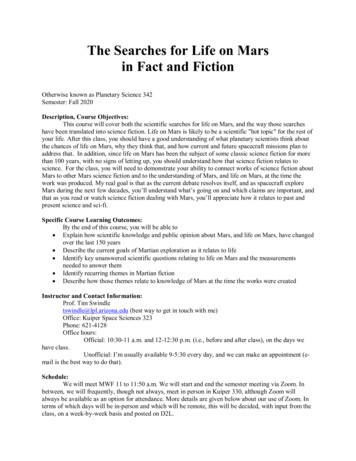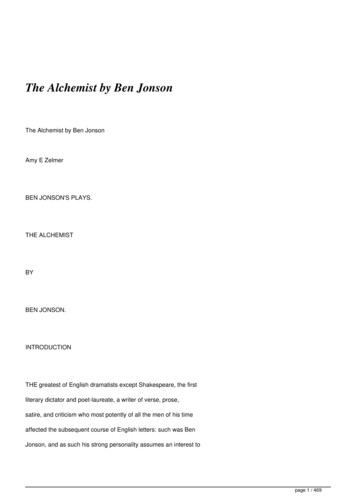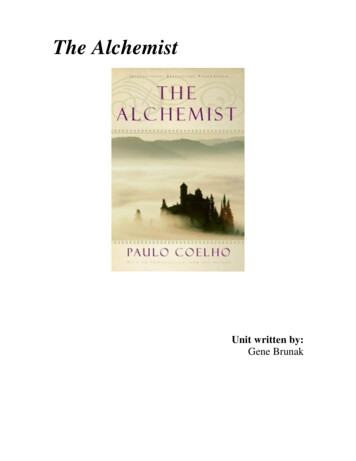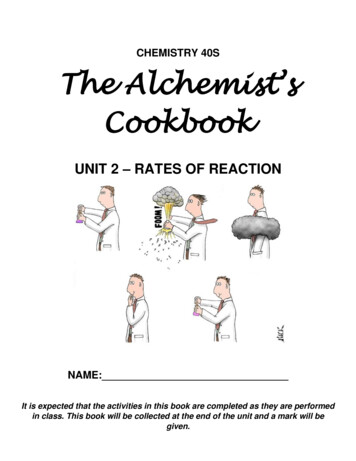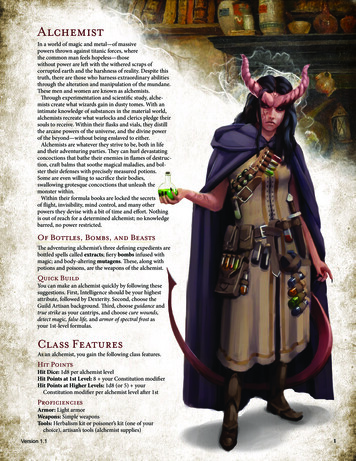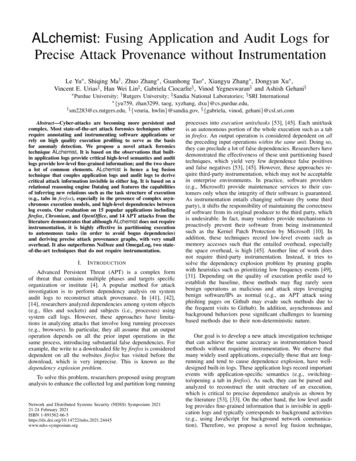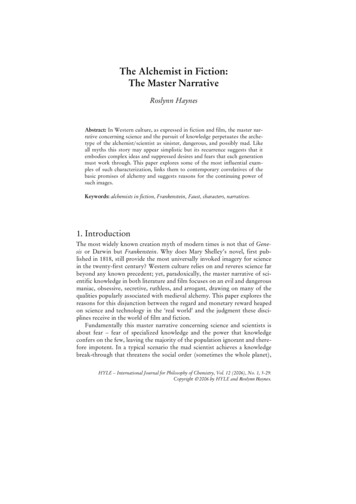
Transcription
The Alchemist in Fiction:The Master NarrativeRoslynn HaynesAbstract: In Western culture, as expressed in fiction and film, the master narrative concerning science and the pursuit of knowledge perpetuates the archetype of the alchemist/scientist as sinister, dangerous, and possibly mad. Likeall myths this story may appear simplistic but its recurrence suggests that itembodies complex ideas and suppressed desires and fears that each generationmust work through. This paper explores some of the most influential examples of such characterization, links them to contemporary correlatives of thebasic promises of alchemy and suggests reasons for the continuing power ofsuch images.Keywords: alchemists in fiction, Frankenstein, Faust, characters, narratives.1. IntroductionThe most widely known creation myth of modern times is not that of Genesis or Darwin but Frankenstein. Why does Mary Shelley’s novel, first published in 1818, still provide the most universally invoked imagery for sciencein the twenty-first century? Western culture relies on and reveres science farbeyond any known precedent; yet, paradoxically, the master narrative of scientific knowledge in both literature and film focuses on an evil and dangerousmaniac, obsessive, secretive, ruthless, and arrogant, drawing on many of thequalities popularly associated with medieval alchemy. This paper explores thereasons for this disjunction between the regard and monetary reward heapedon science and technology in the ‘real world’ and the judgment these disciplines receive in the world of film and fiction.Fundamentally this master narrative concerning science and scientists isabout fear – fear of specialized knowledge and the power that knowledgeconfers on the few, leaving the majority of the population ignorant and therefore impotent. In a typical scenario the mad scientist achieves a knowledgebreak-through that threatens the social order (sometimes the whole planet),HYLE – International Journal for Philosophy of Chemistry, Vol. 12 (2006), No. 1, 5-29.Copyright 2006 by HYLE and Roslynn Haynes.
6Roslynn Hayneseither through evil designs or by accident (‘collateral damage’ in today’s media-speak). Even though the disaster may be (and usually is) averted, thememory of disempowerment remains, augmenting the repository of previousfears, to be recalled the next time there is a new knowledge breakthrough andhence the perception of a new threat.The origins and trappings of this potent story lie in the precursor ofchemistry, alchemy. Although dismissed by scientists as outmoded and irrelevant to their practice, alchemy has continued to provide a potent source ofmyth-making for the critique of modern science. Its chequered reputationhas been revived and reinforced as perennially pertinent by writers, by artistsand film-makers and, perversely, by scientists themselves in response to boththeir own psychological proclivities and the constraints placed on them bycontemporary scientific culture with its emphasis on the priority of publication and by military or industrial requirements of secrecy.2. The popular appeal of alchemyThe craft of alchemy both intrigued and frightened those who hovered on itsfringes. Its allure lay in the immensity and immediacy of its promises and itsprofessions of power surpassing that of kings or priests. In their most crudeform these promises might now seem to appeal only to the excessively naïveor the inordinately greedy, yet in their generic form they continue to behighly attractive. To understand the ongoing fascination with the figure ofthe alchemist, we need to review some of the perceived foci of alchemy andthe way in which they achieved a paradigmatic status, as well as the origins ofthe evil reputation that coalesced about such practices.The history of alchemy has been well documented (Burckhardt 1967, Caron et al. 1961, Cummings 1966, Debus et al. 1966, Edwardes 1977, Gettings1986, Hollister 1990, Lindsay 1970, Read 1947) and will be familiar to readersof this journal, so here I shall select for mention only those particular preoccupations that seized the imagination of the medieval public and have continued to provide material for fiction, being constantly re-invented and reapplied to claim relevance to contemporary issues or to add a degree of universality to fictional representations of the scientist.Among the foundational concepts of alchemy the following have retainedan allure that is both theoretically satisfying and appealing to self-interest.(a) The notion that all things are interchangeable and exist in a state offlux. One source for this premise was the Taoist belief, originating in Chinain the fifth century BCE, that transformation and change are essential andinnate in all things. In Europe, parallel ideas were put forward by the philos-
The Alchemist in Fiction: The Master Narrative7opher Empedocles and further developed by Aristotle in his thesis regardingthe unity of matter and the interchangeable qualities of the four elements.The aspect of Aristotle’s theory immediately seized upon was his premisethat everything in nature strives towards perfection. Since gold was considered the most perfect and noble state of matter, it followed that all basermetals must necessarily ‘aspire’ to become gold. This changed a general, theoretical principle into a specific, material one, with the added implication ofinevitability. The alchemist’s task was simply to assist nature in realizing itsgoal. In practical terms, this role had been regularly performed by Egyptianmetalworkers who, using the secret recipes of the goddess Isis, were adept at‘extending’ a given quantity of gold by producing alloys with silver, copper,tin, and zinc. Thus, from the beginning, alchemy was associated both withthe apparent ‘production’ of gold and, simultaneously, with the suspicionthat this was a deception, a confidence trick practiced on the greedy and thegullible.In the eighth century these secrets of metallurgy passed to the Arabs who,through trade with the Chinese, added the idea of a transforming catalyst, theorigin of the Philosopher’s Stone, that would enable, or at least assist, basemetals to be transformed into gold. Inevitably such a catalyst conferred power and subsequently wealth on the alchemist who claimed to possess it and tohave the knowledge necessary to activate it.(b) The ‘elixir of youth’, a universal panacea that would cure illness andprevent ageing, thereby conferring longevity, perhaps even immortality. Likethe Philosopher’s Stone for transformation of metals, the elixir of youth wasa catalytic substance, usually a powder or liquid. As pharmacy developedfrom herbalism this alleged elixir achieved greater credibility.These two aspects of alchemy were studied and written about at length bythe Arabs for whom they were associated with the Islamic faith, part of a holy search for perfection. In medieval Christian Europe it was a very differentstory. These two projects were cause enough for suspicion but the third major preoccupation of alchemy finally placed it beyond the tolerance of theChurch.(c) Creation of homunculi. Compared with the previous two, this projectmight seem less desirable, even bizarre, but it constituted an even greaterthreat to the social fabric and to the doctrines of the medieval Church. Although the other claims of alchemy involved a degree of arrogance in the profession of ‘unnatural’ powers, the attempt to produce a tiny human being(always a masculine person) was an example of extreme hubris, since itclaimed to by-pass both the Creator and the divinely ordained method forreproduction. It challenged the Church’s teaching that the soul was created atthe moment of conception and mimicked both the Greek legend of Prometheus moulding humans from clay and breathing life into them, and the crea-
8Roslynn Haynestion story of Adam in Genesis. The sub-title of Frankenstein is ‘or, the Modern Prometheus’ and in her epigraph from Milton Shelley makes specific reference to the parallel between Frankenstein’s creation of his Monster (an outsize parody of the homunculus) and the genesis of Adam:Did I request thee, Maker, from my clayTo mould me man? Did I solicit theeFrom darkness to promote me? [Shelley 1996, p. 3]The Monster, too, compares his own creation to that of Adam. “Remember,that I am thy creature: I ought to be thy Adam: but I am rather the fallenangel, whom thou drivest from joy for no misdeed.”(Shelley 1996, p. 66)We can understand the appeal of the homunculus-peddlers better if werealize that robots are of the same conceptual family. They, too, represent‘beings’ we have created at will through our intellect, without recourse tofemale biology, and which we hope to enslave. In contemporary biologicalterms, cloned organisms, genetic engineering, in vitro fertilization, and embryo transfers involve a comparable desire to take control of the genesis oforganisms, especially in relation to humans.3. The public image of alchemistsBecause alchemy re-entered Europe through translations of Arabic writings,it became a casualty of transferred racism and religious prejudice. Its practicaland socially acceptable origins in metallurgy and medicine were soon obscured and instead it was associated by name and origin with a race regardedas infidels. Linked with the black arts, with heresy, astrology, and magic, itwas decried and finally outlawed by the Church. A series of Acts were passedforbidding the practice of alchemy, culminating in Pope John XXII’s formaledict Spondent, denouncing the alchemists as tricksters and counterfeiters(Duncan 1968, pp. 636f.). It was widely believed that alchemists were inleague with the devil and that those who patronized their services were indanger of eternal damnation. Concealment, isolation, and the arcane symbolic language of the Hermetic tradition were evolved not only as a mechanismto guard secret knowledge, but also as a strategy for survival in the face ofpersecution. At first the astrological signs of the planets were used as alchemical symbols; later alchemists invented their own secret symbols. The ‘Tableof Chemical Symbols’ in the Encyclopédie of Denis Diderot and Jeand’Alembert in the late eighteenth century still resembles the medieval alchemists’ symbols. These characteristics, accidents of history, have been perpetuated in fiction, not only in relation to alchemists but as essential features in
The Alchemist in Fiction: The Master Narrative9the characterization of modern scientists, especially chemists, as cloistered,secretive, engaged in practices that violate the norms and moral values of society, speaking a language and writing in symbols designed to exclude theuninitiated.Despite this reputation of illicit practices and even condemnation by theChurch, alchemists exerted a continuing fascination because of their alluringpromises. In various forms these all represented power to transcend the normal limitations of the human condition – the power of wealth, power overageing and death, and power over the creation of life. For this reason alchemists were wooed by princes1 and paupers alike, even though their clientsmay have suspected that they were being deluded. In modern dress thesepromises remain universally attractive and lucrative propositions, appearingcloser to realization than ever before.4. Prototypes of the alchemist in literatureThe simple medieval stereotypes of the alchemist, memorably represented inChaucer’s The Canon’s Yeoman’s Prologue and Tale (Chaucer 1957, pp. 47398), were the deluded ‘puffer’ who wasted his life and money in the pursuit ofalchemy and the unscrupulous trickster who defrauded others. Althoughthese were later tempered by more benign successors – the natural philosopher and the scientist – the recurrent fictional image of the knowledge-seekerretains many of the characteristics of the alchemist obsessed with the pursuitof dangerous or socially unlawful knowledge. These characters, invariablymale, still shroud their research in secrecy and isolation. Likewise, the masternarrative in which they feature perpetuates the same concerns and repeats thesame moral strictures as were leveled against their predecessors.The alchemist stereotype as we know it today results largely from anamalgam of two fictional characters, so universally recognized and enduringthat they have become prototypes in their own right. Dr Faustus and VictorFrankenstein have continued to provide the imagery, even the iconography,for representations of both the alchemist and modern scientists. The formerfigure provides the link between medieval superstition and Renaissance aspirations to understand Nature, while the latter situates archetypal desires andknowledge hubris within the context of a recognizably modern world.4.1 FaustProbably derived originally from the real-life Georg Faust of Knittlingen,2Faust in all his literary manifestations was depicted as displaying intellectual
10Roslynn Haynesarrogance and an obsession with transcending the boundaries of humanknowledge. Circulated orally, the Faust legends became increasingly exaggerated, involving magic and familiars. The first written account, the anonymousSpieß edition of Historia von D. Johann Fausten of 1587 had an unmistakablereligious moral, focusing on the pact with the devil and Faust’s gruesomeend, accompanied by suitable passages from Scripture. However, The TragicalHistory of Doctor Faustus (1604), written only seventeen years later by English playwright Christopher Marlowe, presented the story in a quite differentlight. Although the incidents of Marlowe’s play were based on those in theEnglish translation of the Spieß text, the assessment of the protagonist istotally divergent.Marlowe’s Faust is a man of his time. His Renaissance-humanist longingto transcend the limitations of the human intellect is still tempered by themedieval awareness that such an aspiration, like Lucifer’s revolt against God,is doomed to destroy him. Yet Marlowe contrives to imply that his ultimatedestruction is the tragic waste of a gifted man. The kind of Faust figure thatpredominates at any point in history is an index of the status accorded by asociety (or an author) to the individual and to the intellect, as opposed to thevalue placed on obedience to the prevailing hegemony, whether Church orState. At one end of the evaluation spectrum, Faust is condemned for hishubris and arrogant denial of God-given limits, and thoroughly deserves histerrible end. At the other extreme, Faust represents a noble Prometheus figure, asserting the right to freedom of knowledge and the full development ofthe individual’s powers against a repressive regime, whether of Zeus, theChurch, or public opinion. This is the Faust of German Romanticism, ofKlinger, Goethe, and Lessing. Scientists are still regularly characterized acrossa similar range, depending on prevailing social and moral support for the intrinsic value of knowledge or for the contrary view that it should be subsidiary to the public interest and, if necessary, suppressed.4.2 FrankensteinMary Shelley’s character Frankenstein has become an archetype in its ownright, universally referred to and providing the dominant image of the scientist in twentieth-century fiction and film. Frankenstein is the prototype ofthe mad scientist who hides himself in his laboratory, secretly creating not anelixir of immortality but a new human life, only to find he has created a Monster. Not only has his name become virtually synonymous with any experiment out of control, but also his relation with his creation has become, inpopular misconception, complete identification: Frankenstein is the Monster.The power of the Frankenstein story can be attributed to the fact that, in itsessentials, it was a product of the subconscious rather than the conscious
The Alchemist in Fiction: The Master Narrative11mind of its author and thus, in Jungian terms, draws upon the collective unconscious of the race.The circumstances of the composition of Frankenstein, as described bythe author in her Introduction to the 1831 edition, are almost as well knownas the story itself and have themselves inspired other fictional accounts including a film and an opera3. Yet it is worth stressing that, according to MaryShelley, the story was produced by the concurrence of two specific factors:the need to produce a horror story and the account of an alleged scientificexperiment. Mary and Percy Shelley, their baby son William and Mary’s stepsister Claire Clairmont were spending the summer of 1816 near Geneva, asneighbors of the poet Lord Byron and his personal physician Polidori. Keptindoors by a stretch of bad weather, Byron, Percy, Polidori, and Mary eachagreed to write a ghost story as entertainment. Mary records that she foundgreat difficulty in thinking of a suitable plot until the evening when the others were discussing the latest experiments allegedly conducted by ErasmusDarwin whereby he was said to have “preserved a piece of vermicelli in a glasscase till by some extraordinary means it began to move with voluntary motion. Not thus, after all, would life be given. Perhaps a corpse would be reanimated; galvanism had given token of such things: perhaps the componentparts of a creature might be manufactured, brought together, and enduedwith vital warmth” (Shelley 1996, pp. 171f.). That night Mary allegedlydreamed the central scene of her novel. Doctor Darwin has been transformedinto “the pale student of unhallowed arts, kneeling beside the thing he hadput together” (Shelley 1996, p. 172). This suggests that the very attempt tocreate life was already associated, at least in Mary’s subconscious mind as accessed by her dream, with alchemy, the “unhallowed arts”, with the demonicand the horrific. The problem of finding a subject for her story was instantlysolved: “What terrified me will terrify others; and I need only describe thespecter which had haunted my midnight pillow. [ ] making a transcript ofthe grim terrors of my waking dream.” (Shelley 1996, p. 172)4It is not difficult to supply reasons why the account of Darwin’s allegedexperiments should have had such a profoundly unsettling effect on MaryShelley, aged eighteen, the youngest and least assured person present, andclearly intellectually overawed by the discussion (she tells us that she was “adevout but nearly silent listener”). Only the preceding year, Mary had losther first child born prematurely and had recently undergone a second, difficult confinement. Inevitably she would have felt emotionally disturbed, evenviolated, by a discussion which not only abolished the role of the female inthe creation of life, but trivialized the process by reducing it to “a piece ofvermicelli in a glass case”. Unable to argue at a rational level with the intellectual giants Byron and Shelley, she doubtless suppressed her disquiet, whichemerged violently in her subsequent dream. What is more interesting for the
12Roslynn Haynespurpose of this exploration of images is her immediate identification of thehighly visual nightmare image of the attempt to create life with her earlieraim “to think of a story [ ] which would speak to the mysterious fears ofour nature and awaken thrilling horror” (Shelley 1996, p. 171).Frankenstein is not only the Romantic over-reacher determined to transcend human limitations; he is also the heir of Baconian optimism and Enlightenment confidence that everything can ultimately be known and thatsuch knowledge will inevitably be for the good. “I doubted not that I shouldultimately succeed [ ]. A new species would bless me as its creator andsource; many happy and excellent natures would owe their being to me.”(Shelley 1996, pp. 31f.).Frankenstein also accepts uncritically the reductionist premise of theeighteenth-century mechanists, that an organism is no more than the sum ofits parts. As heir to a such a view, he has no sense of the extraordinary ironyinvolved when he sets out to create a “being like myself” from dead and inanimate components, ignoring the possible need for any living or spiritual elements. Even in retrospect he seems to see no anomaly in this, for he tellsWalton, not without pride: “In my education my father had taken the greatest precautions that my mind should be impressed with no supernatural horrors. I do not ever remember to have trembled at a tale of superstition, or tohave feared the apparition of a spirit.” (Shelley 1996, p. 30)But the being he creates is not merely a mechanism, the sum of its inanimate parts; it is indeed a being like himself, with free will not subject toFrankenstein’s control. As such, it enacts Frankenstein’s own unconsciousdesires, both good and evil, which have been sublimated by the discipline ofhis research program and by cultural censorship. The Monster responds tothe beauties of nature, to the joys of domesticity and the ideas of greatbooks, occupations that Frankenstein had put aside for his research. But italso kills Frankenstein’s younger brother William, his fiancée Elizabeth, andhis friend Henry Clerval, the very people whom Frankenstein is duty-boundto love but whom he has subconsciously wished to be rid of because theyattempt to distract him from his obsession. The Monster is thus both an alterego and a substitute for the natural child he has denied existence by deferringhis marriage with Elizabeth. This Doppelgänger relationship symbolizes thebelief in the essential duality of man, the complex of rational and emotionalselves, mutually alienated but finally inseparable (Bloom 1965, pp. 611-18;Levine et al. 1979, p. 15; Miyoshi 1969, pp. 79-89). This image was to be expanded in Stevenson’s The Strange Case of Dr Jekyll and Mr Hyde (1886). Inthe image of the larger-than-human Monster, Shelley reaffirms the Romanticposition that the unconscious is an intrinsic and more powerful part of thehuman experience than the rational mind and, if suppressed, will ultimatelyemerge to destroy the latter.
The Alchemist in Fiction: The Master Narrative13It is not surprising that playwrights and film makers have returned withsuch frequency to the story, modifying it to suit the prevailing tastes, values,and scientific debates of their time, but it is interesting that no screen versionhas retained Shelley’s pessimistic ending.The first physical presentation of Frankenstein was H.M. Milner’s play of1826, Frankenstein; or, the Man and the Monster and the story became thesubject of one of the earliest films, the Edison Company’s Frankenstein(1910). This film concentrated on the psychological aspects of the story, emphasizing the fact that the creation of the Monster was possible only becauseFrankenstein allowed his normal healthy mind to be overcome by evil andunnatural thoughts. Edison’s ending was far more positive and romantic thanShelley’s, echoing contemporary optimism about science: the Monster finallyfades away, leaving only his reflection in a mirror. And even this is subsequently dissolved into Frankenstein’s own image by the power of Elizabeth’slove. Frankenstein has been restored to mental health and hence the Monstercan no longer exist.Carlos Clerens, the historian of horror films, rates the 1931 Universalfilm classic, Frankenstein, which introduced Boris Karloff as the Monster, as“the most famous horror movie of all time” (Clerens 1967, p. 64). Yet bycomparison with the novel the film is hardly horrific at all. The heavily underlined moral, stated at the beginning, that “it is the story of Frankenstein, aman of science who sought to create a man after his own image withoutreckoning upon God”, restores an element of supernatural order and justiceto Shelley’s entirely secular and unredeemed situation. In this version, HenryFrankenstein (who, following Peggy Webling’s 1930 play on which the film isbased, has exchanged given names with Clerval) is presented as the innocentvictim of a mistake whereby his careless assistant has brought him the brainof a murderer instead of a noble person, for inserting into his creature. Theevil character of the Monster is therefore merely an experimental error, ratherthan the inevitable result of Frankenstein’s hubris, and the implication is thatthe creation of the Monster per se posed no abiding procedural problem; withdue precautions a better result could be obtained next time. Such an attitude,including the otherwise anomalous introductory moral, was consistent withthe adulation of scientists, and particularly of inventors, in the United Statesduring the 1930s (Haynes 1994, pp. 163-5). Although the film ended with theMonster being burnt to death and the celebration of Frankenstein’s weddingto the (spared) Elizabeth, the box-office success indicated a sequel. The finalscenes of the 1931 film were cut from all prints in circulation and Bride ofFrankenstein (1935) opened with a scene in which Mary Shelley relates toShelley and Byron the sequel to her novel. In this film Frankenstein becomesthe pawn of another scientist, the mad, evil Dr Pretorius who, having constructed various homunculi, now wishes to produce something larger. He
14Roslynn Haynesforces Frankenstein to create the mate for which the Monster of the novelhad begged. The female Monster (in an extension of the Doppelgänger effectin the novel she is played by the same actress, Elsa Lanchester, as Mary Shelley) is striking but not hideous and she immediately rejects the Monster whoin despair electrocutes her, Dr Pretorius, and himself. In this film Frankenstein has become entirely absolved of guilt, and the role of the evil scientistbent on creating life, has passed to the alchemist-like Pretorius.Bride of Frankenstein was followed by a long succession of Frankensteinderivatives whose titles are sufficiently indicative of their content and of theway in which Frankenstein has been integrated into Western culture as anever-contemporary by-word, almost as a real person, engaging in dialoguewith other characters both real and imaginary.5 At different periods the emphasis falls variously on horror, space travel, sexuality, or comedy associatedwith the figure of the scientist. One of the most interesting films in terms ofthe application of the Frankenstein story to a contemporary scientific debateis Frankenstein 1970 (1958) in which Boris Karloff returns to the screen asthe disfigured Victor Frankenstein, victim of Nazi torture. By means of anatomic reactor he raises to life the Monster from his ancestor’s 1757 experiment, but they both die a horrible death from radioactivity when the reactorblows up. Only then is the Monster’s face revealed. It is the face of a youthful Victor Frankenstein, symbolizing in startling visual imagery the identification of creator and creature, in this case the atomic scientist and his dangerous and faulty creation, atomic power.5. The endurance of the alchemist stereotypeIt may seem anomalous that, after the rise of the great scientific societies inthe seventeenth century and the European Enlightenment of the eighteenthcentury with its emphasis on rationality, this archetype has endured, not onlyin fiction but also in the more recent medium of film. From his extensiveanalysis of horror films in English between 1931 and 1960, Andrew Tudorestimated that 30% of the villains were scientists; 40% of the threats werespin-offs from science; and a mere 10% of the heroes were scientists (Tudor1989b, pp. 589-92). It should be noted that, whether noble or evil, the scientist figure remained overwhelmingly male even when this no longer reflectedthe actual degree of involvement of women in science.The most obvious reason for the perpetuation of the evil alchemist figureis that the personality traits to which alchemy appealed – greed, vanity, desirefor power, immortality, and manipulation of other human beings – remain
The Alchemist in Fiction: The Master Narrative15prevalent and those who profess to satisfy them in some form continue to beregarded with mingled fascination and fear.However, I want to suggest ten more specific reasons for the persistenceof the alchemist-derived character and for the imaginative power it continuesto exert.(i) One of the most common forms of the stereotype, the seeker afterforbidden knowledge, has its roots in much older mythology, suggesting thatit is deeply ingrained in human consciousness, perhaps within the subconscious: the narratives of Eden, of Prometheus, of Daedalus and Icarus, and ofPandora’s Box all feature protagonists who sought transcendent knowledgeand were punished by some higher authority or by the inevitability of events.Coming from this implicit lineage, their modern descendants carry a transferred kudos and more powerful resonances than any ‘new’ story could generate. The scientist who discovers some power (whether it be a weapon ornuclear power or the ability to create, clone, or modify life) that cannot becontained or controlled is Pandora trying vainly to push the escaping Troubles back into the box. Like these archetypal myths, nearly all alchemist narratives focus on a reversal of expectation and consequent nemesis: the glorious promises turn to ashes and destruction – sometimes because they are notachieved, as in Balzac’s La Recherche de l’Absolu (1834), but more often because they are achieved in the short term but bring unforeseen disaster intheir train. The preeminent literary example here is Frankenstein, whosetragedy begins at the precise moment of his experimental success.I saw the dull yellow eye of the creature open; it breathed hard and a convulsive motion agitated its limbs.How can I describe my emotions at this catastrophe? [ ] I had desired itwith an ardour that far exceeded moderation; but now that I had finished, thebeauty of the dream vanished, and a breathless horror and disgust filled myheart. Unable to endure the aspect of the being I had created, I rushed out ofthe room. [Shelley 1996, p. 34](ii) Science, like alchemy, claims access to a kind of po
The Alchemist in Fiction: The Master Narrative 9 the characterization of modern scientists, especially chemists, as cloistered, secretive, engaged in practices that violate the norms and moral values of so-ciety, speaking
